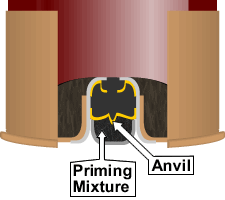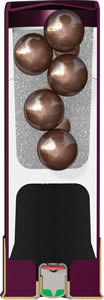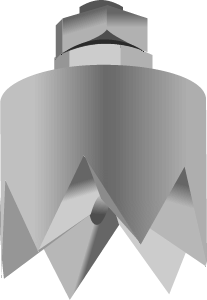Home | Glossary | Resources | Help | Contact Us | Course Map
Archival Notice
This is an archive page that is no longer being updated. It may contain outdated information and links may no longer function as originally intended.
Priming and Loading
For safety reasons, most shotshell priming is performed after case manufacture but prior to loading. This sequence order separates primers and their residue from the propellant charging operation. A primed case is significantly less hazardous than a large quantity of sensitive primers.
Priming machines rotate cases to stations; the primer is fed into position then seated with a punch. The primer-seating punch is designed to push against the sturdy, protective battery cup, leaving the primer cup untouched. This method improves consistency of seating depth and reduces misfire rates. Testing for missing, tipped, and deformed primers may be automated in more modern facilities.
Loading
Loading a shotshell is similar to loading other cartridges, but with a number of additional considerations:
- The propellant selected for powder charging must be consistent with the requirements of shotshells.
- Appropriate wadding material must be inserted within the casing.
- An appropriate projectile(s) must be selected for loading (small pellets, buckshot, or solid projectiles).
- The end of the case must be crimped to keep the contents intact.
Modern high-volume loading machines assemble appropriate propellants, wads, and projectiles in a variety of gauges suitable for many diverse purposes (sporting, police and military use).
Powder
Charging
Shotshell propellants are coarser than rifle and handgun propellants. This seldom poses a problem because both the charge and the case are relatively large. Each case stops under a drop tube that is lowered into the case, delivering a measured amount of propellant. The tube in the case minimizes spilling and facilitates settling of the charge. After charging, the tube withdraws and the case moves to the next position.
Powder Level Verification
In the next dial position, a powder-level detector verifies the newly placed charge.
Wadding
Insertion
A wad (consistent with the type of projectile(s) to be loaded) is inserted. A tubular wad guide enters the case to prevent the soft plastic or fiber wad from snagging on the case mouth. Wads fed from above are oriented and aligned in a magazine. A punch enters the cup portion of the wad directly above the case, pushes it down onto the propellant charge, and applies light pressure. The punch is then withdrawn.
Inspection
The case moves on to an additional inspection station where a sensor rod is used to verify that a wad is present, aligned, and undamaged.
Projectile Loading
The vast majority of shotshells loaded are filled with small lead or nontoxic pellets, such as birdshot. Due to their small size, these pellets can be easily measured by volume. A guide tube is inserted into the case to protect the case mouth and to minimize spillage. The measured charge of shot flows from a storage hopper to the measuring device and on into the case.
Nontoxic shot, particularly steel, may require a special wad with heavier shot cup walls to protect the gun barrel. The loading machine has a different configuration of tool and die settings for lead and steel shot. Shotshells loaded with one-piece projectiles or large buckshot are loaded in much smaller quantities and can be assembled on less sophisticated equipment.
Shot Charge Verification
An inspection station immediately following the shot charging station ensures the proper amount of shot has entered the case.
Crimping
Shotshells can be secured with folded crimps or roll crimps. Folded crimps are informally called pie crimps because of the shape of the sections as viewed on the end of the case. Folded crimps predominate; the roll crimp is reserved for special loads, including buckshot and slugs. Regardless of the crimp type, crimping paper or plastic shotshell cases must be performed in stages.
A crimp starter is a short die (or two dies in sequence) with internal angled ribs that make small bends in the case mouth. If a two-stage starter is used, the case is quickly moved from the first to the second stage before the case mouth springs back. The second die extends the full length of the fold and forces the resulting segments inward. At this point, the segments are within forty-five to sixty degrees (from the vertical) of meeting level in the middle.
The crimper is a die containing a concentric punch and is sized to fit the outside of the case. When the case is captured in the die, the flat-faced punch pushes on the folds, forcing them to meet (as close as possible) in a single plane. This tooling is also designed to push the finished folded crimp below the new edge of the case, helping to lock the crimp in place.
As an option, a crimp finisher may be employed to give a slight taper to the case mouth for smoother feeding in repeating shotguns. This device is a spinning cup (with tapered inside walls) that rotates fast enough to soften plastic or wax-impregnated paper. Mild heating produced by the friction of the rotation helps the case mouth to retain its shape.
Some folded crimps in plastic shotshells are further sealed for moisture resistance by the application of wax or another thermal sealant directly on the center of the crimp. Cases may be thermally sealed by applying heat to the center of the folds, welding the segments together. Thermal sealing is more commonly found in inexpensive loads where the cases are not likely to be reused because the heat seal damages the case mouth.
Roll crimping can be used to hold an overshot wad or a slug. This must also be performed in stages and is seldom accomplished on high-speed equipment. The simplest roll crimper is a spinning die with an internal shape that duplicates the desired cross-sectional profile of the finished case mouth. Lowered slowly onto a case mouth, the spinning action of the die heats the case material enough for it to move. As the die lowers, the mouth is forced inward and over a shoulder in the roll crimper, completing the required 180-degree turn.
Testing
With the exception of accuracy testing, shotshells loaded with pellets receive the same stringent testing as rimfire and metallic ammunition. Random samples may be tested for patterning. With proper loading controls, the initial testing performed in the development of a shot load should be sufficient to maintain the desired pellet density and distribution.
In contrast, shotshells loaded with single slugs are tested for accuracy. The accuracy of shotgun slugs is marginal compared to rifle ammunition.
Additional Online Courses
- What Every First Responding Officer Should Know About DNA Evidence
- Collecting DNA Evidence at Property Crime Scenes
- DNA – A Prosecutor’s Practice Notebook
- Crime Scene and DNA Basics
- Laboratory Safety Programs
- DNA Amplification
- Population Genetics and Statistics
- Non-STR DNA Markers: SNPs, Y-STRs, LCN and mtDNA
- Firearms Examiner Training
- Forensic DNA Education for Law Enforcement Decisionmakers
- What Every Investigator and Evidence Technician Should Know About DNA Evidence
- Principles of Forensic DNA for Officers of the Court
- Law 101: Legal Guide for the Forensic Expert
- Laboratory Orientation and Testing of Body Fluids and Tissues
- DNA Extraction and Quantitation
- STR Data Analysis and Interpretation
- Communication Skills, Report Writing, and Courtroom Testimony
- Español for Law Enforcement
- Amplified DNA Product Separation for Forensic Analysts




